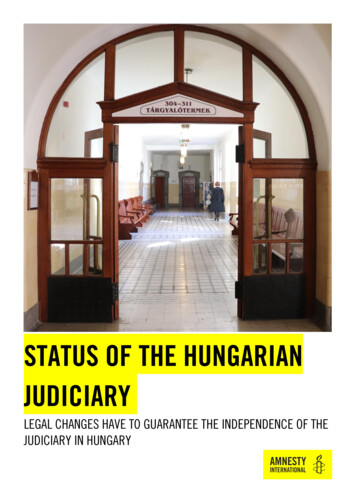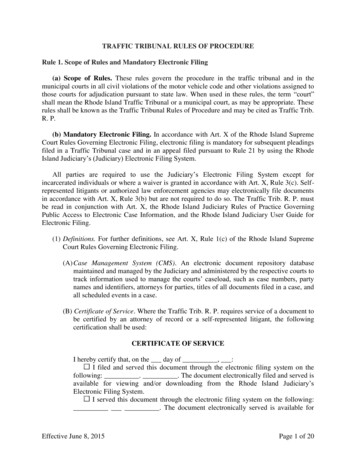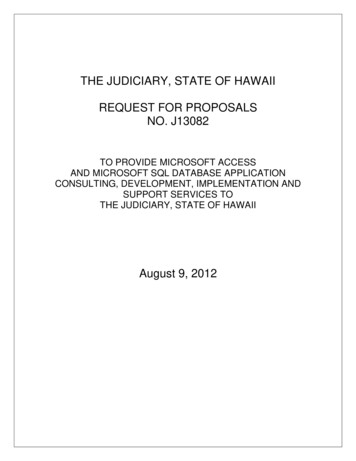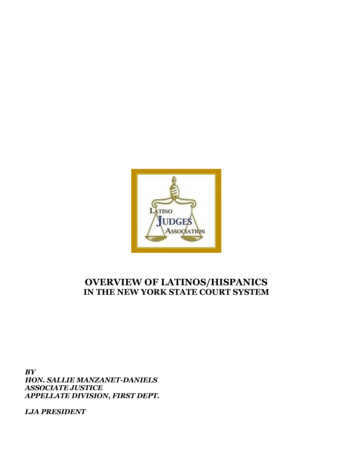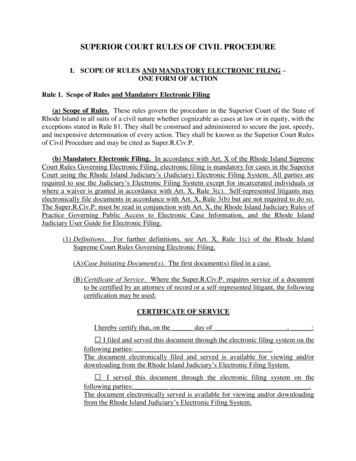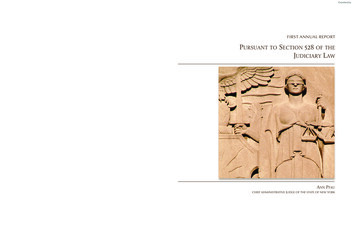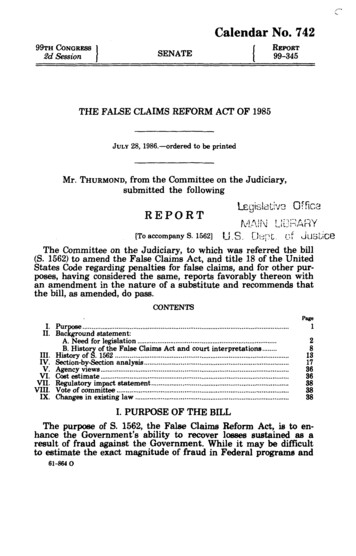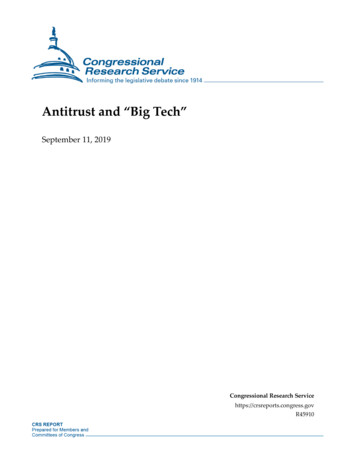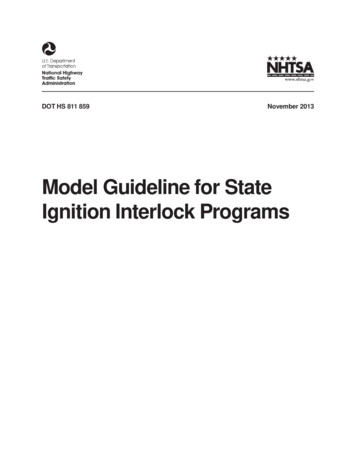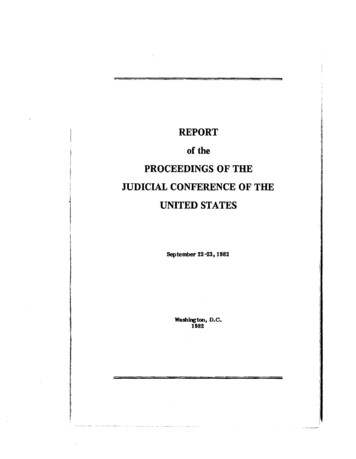
Transcription
REPORTof thePROCEEDINGS OF THEJUDICIAL CONFERENCE OF THEUNITED STATESSeptember 22-23, 1982Wash ton,1982ID.C.
ADMINISTRATIVE OFFICE OF THE TEDSTATESCOURTSWilliam E. FoleyDirector
REPORTof thePROCEEDINGS OF THEJUDICIAL CONFERENCE OF THEUNITED STATESSeptember 22-23, 1982Washington, D.C.1982
THE JUDICIAL CONFERENCE OF THE UNITED STATES, 28 U.S.C. 331§331.JUDIC1AL CONfERENCE Of THE UN1TED STATESThe Chief Justice of the United States shall summon annually the chief judge of eachjudicial circuit, the chief judge of the Court of Claims, the chief judge of the Court of Cus·toms and Patent Appeals, and a district judge from each judicial circuit to a conference atsuch time and place in the United States as he may designate. He shall preside at suchconference which shall be known as the Judicial Conference of the United States. Specialsessions of the conference may be called by the Chief Justice at such times and places ashe may designate.The district judge to be summoned from each judicial circuit shall be chosen by thecircuit and district judges of the circuit at the annual judicial conference of the circuit heldpursuant to section 333 of this title and shall serve as a member of the conference for threesuccessive years, except that in the year following the enactment of this amended sectionthe judges in the first, fourth, seventh, and tenth circuits shall choose a district judge toserve for one year. the judges in the second. firth. and eighth circuits shall choose a districtjudge to serve for two years and the judges in the third, sixth. ninth, and District ofColumbia circuits shall choose a district judge to serve for three years.If the chief judge of any circuit or the district judge chosen by the judges of the circuitis unable to attend, the Chief lustice may summon any other circuit or district judge fromsuch circuit. If the chief judge of the Court of Claims or the chief judge of the Court ofCustoms and Patent Appeals is unable to attend, the Chief Justice may summon anassociate judge of such court. Every judge summoned shall attend, and, unless excused bythe Chief Justice, shall remain throughout the sessions of the conference and advise as tothe needs of his circuit or court and as to any matters in respect of which the administra tion of justice in the courts of the United States may be improved.The conference shall make a comprehensive survey of the condition of business in thecourts of the United States and prepare plans for assignment of judges to or from cir cuits or districts where necessary. and shall submit suggestions to the various courts, in theinterest of uniformity and expedition of business.The conference shall also carry on a continuous study of the operation and effect of thegeneral rules of practice and procedure now or hereafter in use as prescribed by theSupreme Court for the other courts of the United States pursuant to law. Such changesin and additions to those rules as the conference may deem desirable to promote simplicityin procedure, fairness in administration, the just determination of litigation, and the e1im·ination of unjustifiable expense and delay shall be recommended by the conference fromtime to time to the Supreme Court for its consideration and aoopti(l1, modification orrejection, in acmrdance with law.The Attorney General shall, upon request of the Chief Justice, report to such conferenceon matters relating to the business of the several coutts of the United States, with par ticular reference to cases to which the United States is a party.The Chief Justice shall submit to Congress an annual report of the proceedings of theludicial Conference and its recommendations for legislation.iv
TABLE OF CONTENTSREPORT OF THE PROCEEDINGS OF THEJUDICIAL CONFERENCE OF THE UNITED STATESSeptember 22-23, 1982PageCall of the Conference . . . . . . . . . . . . . . . . .Report of the Director of the AdministrativeOffice of the United States Courts . . . . Judicial Business of the Courts . . . Judicial Panel on Multidistrict Litigation. . . . . Committee on the Judicial Branch. . . . . Judicial Salary Control Act of 1981 . . . . . . Commission on the Bicentennial ofthe Constitution. . . Committee on Court Administration . Additional Judgeships. . . . . . United States Immigration Court. . . Social Security Court . . . . . Judicial Review of the Denialof Veterans Claims. . . . . . . Contribution and Claims Reductionin Anti trust Cases . . . . . . . . . . . . . . . . . . . . . . . . . . .Congressional Redistricting. . . Review of Decisions of the Employees'Compensation Appeals Board. . Judicial Restraint Act . . Jurisdiction of Bankruptcy Courts . Venue in Courts of Appeals andDistrict Courts. . . . . . . . . . . . . . . . . . . . . . . . . . . . . .National Court of Appeals andIntercircuit Tribunal of theUnited States Courts of Appeals National Judicial Study Commission. Technical Amendments to Title 28,United States Code, Section 1364 Residences of Clerks of Court. . . . . Places of Holding Court Waiver of Overpayments. . . . Court Interpreters Act Travel Regulations for Justicesand Judges. . . . . . . . . . . . . . . . . . . . . . . . . . . . . . . . 374
Court Administration (Cont'd)Litigation Expenses of Judicial Officers. . . . . . . . . Miscellaneous Fees . . . , . . . . . Space Utilization Survey. . . . . . . . . . . . Authorization of TemporaryPersonnel for Judges. . . . . . . . . . . . . . . . . . . . . .Court Reporters. . . . . . . . . . . . . . . . . . . . . .Changes in Authorization and Compensationof Supporting Clerical Staff . . . Committee on the Budget. . . . . . . . . . . . . . . . . . . . . . .Appropriations for the Fiscal Year 1984 . . . . . . Supporting Personnel for Senior Judges . .Judicial Ethics Committee . . . . .Activities of the Committee. . . . . . . . . . . . .Reporting Form and Instructions. . . . . . . . . Advisory Committee on Codes of Conduct . . . . . . Activities of the Committee. . . . . . . Applicability of Codes of Conduct. . . . Model Codes of Conduct for VariousJudicial Employees. . . Senior Judges Serving as Arbitrators . Committee on Intercircuit Assignments. Committee on Rules of Practiceand Procedure . . . . Bankruptcy Rul es . . . . Criminal Rules. . . . . . . . . . . . . 757677777980808081818182838383848484858585Civil Rules. . . . . . . . . . . . . . . . . . . . . . . . . . . . . . . . . .86Appellate Rules . . . . . . . . . . . . . Statement of Operating Procedures. . . . . Committee on the Administration ofthe Probation System . . . . . . Sentencing Institutes . . . Sentencing Reform. . . . . . . . . . Committee on the Administration of theBankruptcy System. . . . Survey of the Need for Bankruptcy Judges. . Arrangements for Bankruptcy Judges. Guidelines for Chapter 13 Administration. Jurisdictional Conflicts. Bankruptcy Appeals in District Courts. . . Committee on the Administration ofthe Federal Magistrates System. Jurisdiction of Magistrates Qualification Standards andSelection Procedures Changes in Magistrates Positions. . 8686vi87878788888890919192929394
Committee to Implement the CriminalJusti ce Act . . . . . . . . . . . . . . . . . . . . . . . . . . . . . .Appointments and Payments. . . . . . . . . . . . . . .Budget Requests - Federal PublicDefenders . . . . . . . . . . . . . . . . .Grant Requests - Community DefenderOrganizations. . . . . . . . . . . . . . . . . . Funding for the Federal Public Defenderin the Southern District of Florida. . . . . . . . Guidelines . . . . . . . . . . . . . . . .Committee on the Administration ofthe Criminal Law. . . . . . . . . . . . . . . . .Interlocutory Appeals . . . . . . . . . Sealing of Records Under the YouthCorrections Act. . . . . . . . . . . . . . . . . . .Amendments to the Smuggling Statute. . . . . . . . . .Commitment of Mentally IncompetentOffenders . . . . . . .Committee on the Operation of theJury System . . . . . . . . . .Judges' Manual for the Managementof Com plex Criminal Jury Cases . . . . . . . . Periodic Reporting - Jury Selection. . . . Voir Dire Examination . . . . Witnesses Before Grand Juries. . . . . . . .Tax Treatment of Jurors' Attendance Fees. . . . .Juror Qualification Questionnaire . . Implementation Committee on Admissionof Attorneys to Federal Practice. . . Committee on Pacific Territories. . . . . . . . . Committee on Judgeship Vacancies . . . . .Ad Hoc Committee on the Dispositionof Court Records . . . . . .Records Disposition Program and Schedule. . . . .Termination of the Work of the Committee Elections . . . . . . . . . . . . . . . . . . . . . . . . . . . . . . . . . . . . .Committee to Review Circuit CouncilConduct and Disability Orders. . . . Committee on the Selection of Law Clerks. . . . . . . . . . . Ad Hoc Committee on Judicial ReviewProvisions in Regulatory Reform10710710810911 18118119119120120Legisla ti on. . . . . . . . . . . . . . . . . . . . . . . . . . . . . . . . .120Courtroom Facilities . . . . Pretermission of Terms of theCourts of Appeals.Release of Conference Action. 121vii121121
REPORT OF THE PROCEEDINGSOF THE JUDICIAL CONFERENCEOF THE UNITED STATESSeptember 22-23, 1982The Judicial Conference of the United States convenedon September 22, 1982, pursuant to the call of the ChiefJustice of the United States, issued under 28 U.S.C. 331, andcontinued in session on September 23rd. The Chief Justicepresided and the following members of the Conference werepresent:First Circuit:Chief Judge Frank M. CoffinJudge W. Arthur Garrity, Jr., District of MassachusettsSecond Circuit:Chief Judge Wilfred FeinbergChief Judge Constance B. Motley, Southern District ofNew YorkThird Circuit:Chief Judge Collins J. SeitzChief Judge Gerald .T. Weber, Western District ofPennsylvaniaFourth Circuit:Chief Judge Harrison L. WinterJudge Robert R. Merhige, Jr., Eastern District of VirginiaFifth Circuit:Chief Judge Charles ClarkChief Judge John V. Singleton, Jr., Southern District ofTexasSixth Circuit:Chief Judge George C. Edwards, Jr.Chief Judge Frank J. Battisti, Northern District of Ohio
56Seventh Circuit:Chief Judge Walter J. CummingsChief Judge John W. Reynolds, Eastern District ofWisconsinEighth Circuit:Chief Judge Donald P. LayJudge Albert G. Schatz, District of NebraskaNinth Circuit:Chief Judge James R. BrowningJudge Manuel L. Real, Central District of CaliforniaTenth Circuit:Chief Judge Oliver SethChief Judge Luther B. Eubanks, Western District ofOklahomaEleventh Circuit:Chief Judge John C. GodboldJudge William C. O'Kelley, Northern District ofGeorgiaDistrict of Columbia:Chief Judge Spottswood W. Robinson, IIIChief Judge Aubrey E. Robinson, Jr., District of ColumbiaCourt of Claims:Chief Judge Daniel M. FriedmanCourt of Customs and Patent Appeals:Chief Judge Howard T. MarkeyCircuit Judges Irving R. Kaufman, Anthony M. Kennedy,Otto R. Skopil Jr., Edward A. Tamm, and Gerald B. TjoflatjSenior Circuit Judges Clement F. Haynsworth, Jr. and CarlMcGowan; Senior District Judges Elmo B. Hunter and Thoma J. MacBride; and District Judges T. Emmet Clarie, Robert E
57DeMascio, Edward T. Gignoux and Alexander Harvey II,attended all or some of the sessions of the Conference.The Deputy Attorney General of the United States,Honorable Edward C. Schmults, and the Solicitor General ofthe United States, Honorable Rex E. Lee, addressed theConference briefly on matters of mutual interest to theDepartment of Justice and the Conference.William E. Foley, Director of the Administrative Officeof the United States Courts; Joseph F. Spaniol, Jr., DeputyDirector; James E. Macklin, Assistant Director; William J.Weller, Legislative Affairs Officer; Michael J. Remington,Deputy Legislative Affairs Officer; Deborah H. Kirk, Chief,Office of Management Review; and Charles W. Nihan, DeputyDirector of the Federal Judicial Center, attended sessions ofthe Conference. Mark W. Cannon, Administrative Assistant tothe Chief Justice, and John Yoder of the Supreme Court staff,attended sessions of the Conference. The Director of theFederal JUdicial Center, A. Leo Levin, presented the Center'sAnnual Report.REPORT OF THE DffiECTOROF THE ADMINISTRATIVE OFFICEOF THE UNITED STATES COURTSThe Director of the Administrative Office of the UnitedStates Courts, William E. Foley, submitted to the Conferencethe Annual Report of the Director for the year ended June 30,1982. The Conference authorized the Director to release theAnnual Report immediately in preliminary form and to reviseand supplement the final printed edition.Separate reports on payments under the Equal Access toJustice Act and on the operation of equal employmentopportunity plans in the courts, filed by the Director, were alsoreceived by the Conference and authorized to be released.JUDICIAL BUSINESS OF THE COURTSMr. Foley reported that appeals docketed in the UnitedStates courts of appeals during the year ended June 30, 1982increased 6 percent to a record 27,947 appeals filed. Duringthe year the courts of appeals terminated 27,984 appeals, an
58increase of 11.6 percent over the previous year and 38 appealsmore than the number filed. As a result, the number ofappeals pending on June 30, 1982 rleclined for the first timesince 1958 to 21,510 pending appeals.Civil cases filed in the United States district courtsduring the year ended June 30, 1982 were 206,193, an increaseof 14.2 percent over the 180,576 civil cases filed during theprevious year. There were 189,473 civil cases terminated, 6.5percent more than the previous year, and the pending civilcaseload increased 8.9 percent to a record 205,434 cases as ofJune 30, 1982.Criminal cases filed in the district courts in 1982climbed to 32,682, an increase of 4.5 percent over 1981. Therewere 31,889 criminal cases closed during the year, and on June30, 1982 there were 16,659 criminal cases pending, an increaseof 5.1 percent. During the year prosecutions for marijuanadrug violations increased 39.9 percent and all other drugrelated cases increased 11.5 percent. Prosecutions under lawsrelating to weapons and firearms continued to increase duringthe year, rising 36.2 percent. Prosecutions for forgery andcounterfeiting also rose substantially increasing 17.6 percent,while auto theft prosecutions increased 21.0 percent.During the year ended June 30, 1982 there were 367,866bankruptcy cases, representing 527,342 separate estates, filedin the United States bankrupcy courts. An additional 469estates in cases originally filed under the Bankruptcy Act priorto October I, 1979 were reopened. The bankruptcy courts thusreceived 527,811 new bankruptcy cases during the year, anincrease of 1.7 percent. This is a leveling off in the filing ofbankruptcy estates from the increase of 43.8 percent in 1981and 59.4 percent in 1980. There were 412,852 bankruptcyestates closed during the year, an increase of 28.3 percent overthe previous year, but almost 215,000 estates less than thenumber filed. As a result the number of estates pending on thedockets of the bankruptcy courts on June 30, 1982 increased18.6 percent to a record 723,871.JUDICIAL PANEL ON MULTIDISTR[CT LITIGATIONA written statement filed with the Conference by theJudicial Panel on Multidistrict Litigation indicated that duringthe year ended June 30, 1982 the Panel had acted on 683 civil
59actions pursuant to 28 U.S.C. 1407. Of that number, 454actions were centralized for consolidated pretrial proceedingswith 229 actions already pending in the various transfereedistricts at the time of transfer. The Panel denied transfer of155 civil actions.Since its creation in 1968 the Panel has transferred11,094 civil actions for centralized pretrial proceedings incarrying out its responsibilities.As of June 30, 1982,approximately 8,814 cases had been remanded for trial,reassigned within the transferee district, or terminated in thetransferee court.On June 30, 1982 there were 2,280transferred civil actions being processed by transferee judges.COMMITTEE ON THE JUDICIAL BRANCHJudge Irving R. Kaufman, Chairman of the Committeeon the Judicial Branch, submitted the Committee's report.JUDICIAL SALARY CONTROL ACT OF 1981S. 1847, 97th Congress, is a bill to prohibit any futureincreases in salaries of Federal judges absent an affirmativerecord vote in both Houses of Congress, and to require anannual review by both Houses of Congress of all standingSUbstantive program authorizations for judicial branchactivities. The Conference in March 1982 (Conf. Rept. p. 5)recognized the ultimate final authority of Congress to setjudicial salaries, but expressed its preference for the draftlegislation to create a biennial commission on judicial salariespreviously approved by the Conference. The Conferencefurther agreed that the bill's objectives with respect to annualprogram authorizations are unnecessary and unwise.Judge Kaufman stated that the Committee had againreviewed this proposed legislation and concluded that theJudicial Conference should renew its opposition to the passageof S. 1847 or any successor legislation.Upon therecommendation of the Committee the Conference adoptedthe following resolution:Resolved, that the Judicial Conference of theUnited States opposes the passage of S. 1847 orof any bill replacing or resembling it, or
flOproviding for annual program oversight of judicialoperations.COl'vtl'lHSSION ON THE BICENTENNIAL OFTHE CONSTITUTIONJudge Kaufman stated that the Committee hadunanimously endorsed pending legislation, S. 2671, 97thCongress, which would establish a Commission on theBicentennial of the Constitution to promote and coordinateactivities to commemorate the wisdom and endurance of thatdocument. The Committee noted that the bill would providefor the appointment of Commission members by the Presidentfrom lists of nominees submitted by the Speaker of the House,the President Pro Tempore of the Senate and the Chief Tusticeof the United States.The Conference agreed that aBicentennial Commission with appointments made incooperation with all three separate branches of theGovernment will enable the Nation to celebrate thebicentennial appropriately and voted to approve the legislation.The Conference authorized theCommittee's report to all Federal judges.releaseoftheCOMMITTEE ON COURT ADMINISTRATIONJudge Elmo B. Hunter, Chairman of the Committee onCourt Administration, presented the report of the Committee.ADDITION AL JUDGESHIPSJudge Hunter informed the Conference that theCom mhtee had reviewed the results of the 1982 biennialsurvey conducted by the Subcommittee on Judicial Statisticsand had voted to recommend the creation of additionaljudgeships in the United States courts of appeals and in theUnited States district courts. Since the Congress has not asyet acted on the Conference recommendations for additionaljudgeships resulting from the 1980 biennial survey, theCommittee's recommendations include those previously madeby the Conference.
61Upon the recommendation of the Committee, theConference recommended the creation of additional judgeshippositions in the United States courts of appeals as follows:District of Columbia Circuit . . IFirst Circuit . . . 2Second Circuit . . . . . . 2Third Circuit . . 2Fourth C ircui t . . . . . . ISixth Circuit . . . . . . . 4Seventh Circuit . . . . . . 2Eighth Circuit . . . . . . INinth Circuit . . . . . . 5Tenth Circuit . . . . . 2TOTAL . . . . . . . 22Upon the recommendation of the Committee theConference also recommended the creation of additionalpermanent and temporary judgeships in the following UnitedStates district courts, including the conversion of certaintemporary judgeship positions to permanent status:First Circuit:Massachusetts . . . . I 1 temporaryRhode Island . . . 1Second Circuit:Connecti cut. . . New York, Northern . New York, Eastern. .New York, Western. I121 temporaryThird Circuit:New Jersey . . . . . 3Fourth Circuit:Maryland. . . INorth Carolina,Eastern . Item poraryVirginia, Eastern I
62Fifth Circuit:Louisiana, Western . .Mississi ppi,Northern . . . .Mississippi,Southern . . . . . . . . . . . . . 2Texas, Eastern . . . . . . 2Texas, Western. . . . . . . . 1Sixth Circuit:Kentucky, Western. . . . . . . Michigan, Eastern . . Ohio, Northern. . . . . . Tennessee, Eastern. .Tennessee, Western . .121 temporary t/p*11Seventh Circuit:Illinois,Northern . . . . . . . . . 3 1 temporaryIlli nois, Sou t hern . . . 1Indiana,Northern. . . . . . 1 temporaryEighth Circuit:Arkansas,Western. . . . . . . . . I temporaryMinnesota . . . . . . . . . . . t/p*'VI issouri, Eastern . . ]Ninth Circuit:Alaska. . . . . . . . .California, Central. .HawaH . . . Montana . . . Washington,Western. . . . . ]4]II 1 temporary*Existing temporary position to be converted to permanent.
63Tenth Circuit:Oklahoma, Western. . . IWyoming. . . . . . . IEleventh Circuit:Alabama, Southern. . 1Florida, Southern . . . . 3Georgia, Middle . . . 1Total. . . . . . . . 43 8 temporary 2temps. to be madepermanentThe Conference also authorized the Committee toconsider further the need for additional judgeship positions inthe Court of Appeals for the Fifth Circuit, and any emergencyrequests from individual courts and to report thereon at thenext session of the Conference.UNITED STATES IMMIGRATION COURTH.R. 5649 and H.R. 5771, 97th Congress, are identicalbills to amend the Immigration and Nationality Act to createan Article I United States Immigration Court within theExecutive Branch consisting of 50 trial judges, including thechief judge, and seven appellate judges all of whom are to beappointed by the President by and with the advice and consentof the Senate to serve for terms of 15 years and to receive thesame salaries as circuit and district judges.Jurisdh tion would be exclusive in the trial division ofthe court relative to the determination of (a) exclusion cases,(b) deportation cases, and (c) rescission of adjustment of statuscases. In addition, the trial division would determine allapplications for discretionary relief properly raised in theproceedings, including those relating to bond, parole, habeascorpus, or detention of an alien in such proceedings. Thepowers of the district courts to issue writs of habeas corpusand extraordinary writs, and to order injunctive anddeclaratory relief, would be removed from these courts andmade exclusive in the Immigration Court.
64The appellate division of the court would hear anddetermine appeals from (a) final decisions of asylum officers,(b) final adjudicatory decisions of service concerning (1)administrative fines and penalties, (2) petitions forclassification, (3) petitions to classify an alien as an orphan, (4)applications for the exercise of discretionary authority, and (5)final decisions of the judges of the trial division. Decisions ofthe appellate division would be reviewable by the United StatesSupreme Court (1) by appeal from a decision holding an Act ofCongress unconstitutional, and (2) by writ of certiorari grantedupon a petition in a case which did not originate before anasylum officer.Although expressing concern over the constitutionalityof several provisions in the bills, the Committee recommendedthat the Conference take no position on the merits of thelegislation. If, however, the Congress determines that there isa need for a separate Immigration and Naturalization Court,then the Committee recommended that the Conference take mmendations on the creation of a Social Security Court, ora Court of Veterans Appeals, under Article I of theConstitution; that is, that the court be created within theExecutive Branch of Government, that appeals from decisionsof the court not be mandatorily directed to the Supreme Courtbut handled in the same manner as appeals from the Tax Court(to the appropriate court of appeals), and that judicial reviewby the Article m courts be limited to the review pretation. This recommendation was approved by theConference.SOCIAL SECURITY COURTH.R. 3865 and H.R. 5700, 97th Congress, would createan Executive Branch Social Security Court under Article I ofthe Constitution to serve as a judicial forum to review (1) alldecisions rendered under the old-age, survivors, and disabilityinsurance programs, and (2) all final determinations under thesupplemental security income program. The bills differ only inthat H.R. 3865 would create an intermediate review board toaffirm, reverse, remand, or modify an administrative lawjudge's decision before it becomes the final decision of theSecretary.
65The Committee recommended that the Conferencereaffirm its previous recommendation (Conf. Rept. Sept. HISI,p. 67) that factual determinations be made final in theArticle I tribunal and that judicial review in Article III courtsbe restricted to issues of constitutionality or statutoryinterpretation only.Further, appellate review should beprovided in the same manner as appeals from the Tax Court;that is, to the appropriate United States court of appealsrather than the Court of Appeals for the District of ColumbiaCircuit only.JUDICIAL REVIEW OF THE DENIALOF VETERANS CLAIMSS. 349, 97th Congress, is a bill to provide for the judicialreview of denials of veterans claims. The bill would establishprocedures within the Veterans Administration for theadjudication of veterans claims, require the VeteransAdministration to conform to the rule-making procedures ofSec. 553 of the Administrative Procedure Act and provide forthe judicial review of final decisions of the Board of VeteransAppeals in the district courts.The Conference in March 1963 (Conf. Rept. p. 18)disapproved legislation to provide for the review of decisionsof the Administrator of Veterans Affairs in the district courtsand recommended that jurisdiction be vested in a specialExecutive Branch court of appeals.This position wasreaffirmed by the Conference in March 1978 (Conf. Rept. p.9). Because of the constantly growing caseloads of the districtcourts and in the belief that it was not practical or desirable toimpose additional case filings involving veterans appeals onthese courts, the Conference in September 1981 (Conf. Rept.p. 65) voted to recommend that the review of veterans claimsbe conferred exclusively upon the Board of Veterans Appeals orupon a new Executive Branch Article I court, noting that theappellate review of the decisions of the Board of VeteransAppeals, or a new Executive Branch court, by the districtcourts, courts of appeals and Supreme Court, is mostundesirable in view of the potential inpact on the caseloads ofthese courts. In September 1981 the Conference also notedthat if judicial review were deemed to be appropriate, it shouldbe limited to the review of constitutional issues and questionsof statutory interpretation.
66At the suggestion of the Committee the Conferencevoted to renew its recommendation to the Congress that anyinitial review of a decision by the Veterans Administrationdenying a veteran's claim be made by the Board of VeteransAppeals or a new Executive Branch Court of Veterans Appealsand that any appellate review thereafter by district courts belimited to constitutional issues and que
the judges in the first, fourth, seventh, and tenth circuits shall choose a district judge to serve for one year. the judges in the second. firth. and eighth circuits shall choose a district judge to serve for two years and the judges in the third, sixth. ninth, and District of


